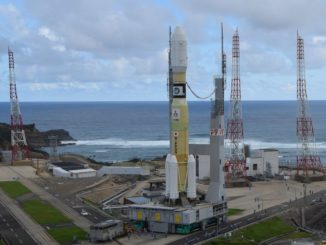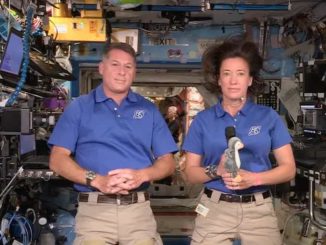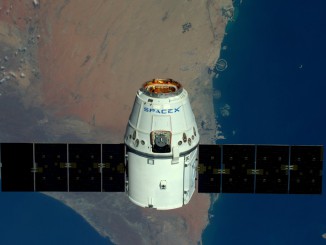
Update 9:02 p.m. EDT: The Cygnus spacecraft missed two burns following spacecraft separation; hope remains for capture and docking Tuesday morning, according to NASA.
While the weather proved challenging heading into Sunday’s launch attempt of the Northrop Grumman-21 (NG-21) cargo resupply mission, SpaceX received enough of a good margin that it was able to launch the NASA mission to the International Space Station.
With a liftoff of its Falcon 9 rocket at 11:02 a.m. EDT (1502 UTC), Northrop Grumman’s Cygnus spacecraft began its roughly 40-hour journey to the orbiting outpost. It deployed its twin circular solar panels at 2:21 a.m. EDT (1821 UTC) to begin charging its batteries.
However, before that happened, at 11:44 a.m. EDT (1544 UTC), NASA said Cygnus didn’t perform its first, planned burn. In a statement published to a NASA blog shortly after 5 p.m. EDT, NASA stated the reason was “due to a late entry to burn sequencing,” but didn’t provide additional clarification as to what exactly this means.
“Known as the targeted altitude burn, or TB1, it was reschedule for 12:34 p.m., but aborted the maneuver shortly after the engine ignited due to a slightly low initial pressure state,” NASA wrote. “There is no indication the engine itself has any problem at this time.”
The astronauts onboard the International Space Station were notified of the missed burns shortly after the second burn was missed. During an unrelated communication between Mission Control Center Houston and NASA astronaut Mike Barratt around 2:30 p.m. EDT, Barratt asked about the status of Cygnus.
He was told that a new burn plan was still in work, but that engineers were still working towards a capture plan on Tuesday. CAPCOM said that “They probably won’t have that by the time you go to sleep, so by the time you wake up, we’ll know what the plan is.”
“Cygnus is at a safe altitude and Northrop Grumman engineers are working a new burn and trajectory plan,” NASA wrote in its blog post. “The team aims to achieve the spacecraft’s original capture time on station, which is currently slated for 3:10 a.m. on Tuesday, Aug. 6.”
After the deployment of the Northrop Grumman Cygnus spacecraft this morning to begin the NG-21 mission, mission control in Houston notified the Expedition 71 crew onboard the space station that “the first two burns were not performed by Cygnus, so they’re reassessing what’s the… pic.twitter.com/8Lm5h5nHKK
— Spaceflight Now (@SpaceflightNow) August 4, 2024
The mission marks the second of three planned launches of a Cygnus on a Falcon 9 rocket while Northrop Grumman and Firefly Aerospace work to build the Antares 330 rocket, which is targeting its first launch in 2025.
NG-21 managed to liftoff from Cape Canaveral Space Force Station as Tropical Storm Debby was barreling towards the Sunshine State. Ahead of the Sunday launch attempt, the 45th Weather Squadron forecast a 10 percent chance of favorable weather conditions at liftoff.
However, as the countdown progressed, conditions ultimately improved to 40 percent favorable, enough to give SpaceX, NASA and Northrop Grumman confidence to proceed with the launch.
“We are not within the cone of the center. However, tropical cyclone impacts do extend far and away from the center,” said Melody Lovin, a launch weather officer with the 45th Weather Squadron, during a prelaunch teleconference on Friday. “So, because of that, Sunday looks like incredibly tricky weather for us, if we do need to utilize that backup launch window.”

Shortly before 8 a.m. EDT on Sunday, the National Hurricane Center issued its eighth advisory regarding Tropical Storm Debby, noting that it was “expected to strengthen rapidly before landfall in the Florida Big Bend region.”
“We’re expecting a steady 25 to 30 miles per hour out of the southeast on Sunday morning,” Lovin said. “Sunday looks pretty tricky, so my team will do their best to find the hole in the clouds tomorrow and get that launch off on time.”
The SpaceX Falcon 9 rocket supporting this mission, B1080 in the SpaceX fleet, launched for a 10th time. It previously launched the Ax-2 and Ax-3 private astronaut missions for Axiom Space; the European Space Agency’s Euclid observatory; and a Cargo Dragon spacecraft on SpaceX’s Commercial Resupply Services-30 (CRS-30) mission.
About seven-and-a-half minutes after liftoff, the booster touched down at Landing Zone 1 (LZ-1) at the Cape, followed quickly by a sonic boom. This was the 42nd landing at that site and the 335th booster landing for SpaceX to date.

Friday afternoon, the SpaceX and Northrop Grumman teams completed the late loading of some of the more time-sensitive items into the spacecraft.
“This is a complex, integrated operation where we’ve rolled out a mobile cleanroom and attached it to the underside of the fairing and allowed access for cargo to be lifted up into the fairing and loaded directly into the Cygnus spacecraft,” said Jared Metter, the director of Flight Reliability for SpaceX.
“We’re leveraging the same operations that we used on the Cygnus flight conducted by SpaceX earlier this year, so the team is highly confident in conducting these complex, integrated operations.”
Cygnus aims to reach the ISS on Tuesday, Aug. 6, and will be captured and berthed using the Canadarm. Once docked, it will remain at the space station until January, at which point it will burn up in the Earth’s atmosphere.
Cygnus separation confirmed pic.twitter.com/0Z3WF03nGx
— SpaceX (@SpaceX) August 4, 2024
Fire simulations, 3D-printed liver, CubeSats and more
Onboard the Cygnus spacecraft are more than 800 kg (1,763 lbs.) of science experiments, which feature a variety of studies. Several of those are being sponsored by the ISS National Laboratory and the U.S. National Science Foundation.
One of those is an experiment that will study the spread of flames to better understand the complex workings behind wildfires. That research is being led by James Urban, an assistant professor within the Fire Protection Engineering Department at Worcester Polytechnic Institute’s (WPI).
Urban did his Ph.D. thesis on how wildfires are started by hot metal particles, like those within power lines, as seen in several large fires in California in recent years. He’s also been impacted indirectly by wildfires, like when he was a college student in California and some of his classes were cancelled due to smoke from wildfires.
“I’ve come to appreciate how large of an impact this problem can have both for the people directly involved, but also over wide geographical areas around the fire,” Urban said.
Urban’s experiment will study non-steady flame behaviors, which he describes as “a complex interaction between the hot gases produced from burning all that vegetation that’s rising and the wind that creates these non-steady behaviors that play a very important role for how the flames spread through the fuel.”
Astronauts on board the ISS will be working with the Combustion Integrated Rack to perform the experiment, which involve about 26 burn samples with each burn test lasting between one to two minutes each. The burn samples won’t be sent back to Earth, but Urban and his colleagues will be receiving video from the experiment.
“For a lot of the flammability research, it’s the video footage you get from the tests that is like really like the gold, the treasure trove. You can extract a lot of really useful information from those videos,” Urban said. “There’s also some other sensors too that you can do that too, but the videos themselves are really, really powerful and allow us to do a lot.”
Another experiment launching is the Maturation of Vascularized Liver Tissue Construct in Zero Gravity (MVP Cell-07), which was developed by Redwire Space in partnership with the Wake Forest Institute of Regenerative Medicine. The experiment is designed to improve the processes for bioprinting in microgravity for on-Earth research as well as creating implantable tissue in the future.
“In this investigation, the researchers determine whether bioprinted liver tissue constructs with blood vessels mature and behave the same way in space, where microgravity causes changes in cell shape, size, volume, and adherence properties,” according to NASA’s description of the experiment. “The team aims to determine whether liver cells form proper tissue structures in microgravity and maintain functionality. The team also assesses whether vascular cells correctly form a lining in the blood vessel walls within the liver construct.”
Two CubeSats are also hitching a ride on the NG-21 mission as part of NASA’s CubeSat Launch Initiative: CySat-1 from Iowa State University and DORA (Deployable Optical Receiver Aperture) from Arizona State University. The former will measure soil moisture using a software-defined radiometer, according to NASA.
DORA is a partnership between ASU and NASA’s Jet Propulsion Laboratory (JPL) in Southern California, which will test new CubeSat technology.
“The technology will demonstrate new optical communications without precision pointing and use a solid-state photon detector to gather high data rates using wide-field optical receivers,” NASA wrote in a blog post. “To test the detector’s performance, DORA will measure the background light from reflected sunlight, moonlight, and city lights when deployed from the space station into low Earth orbit.”




